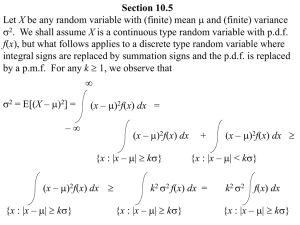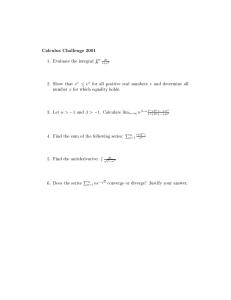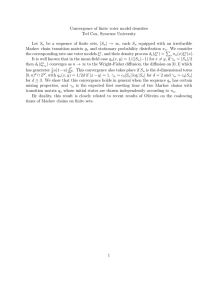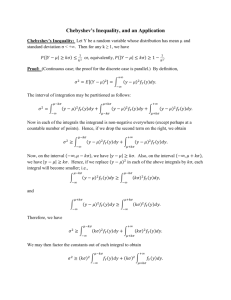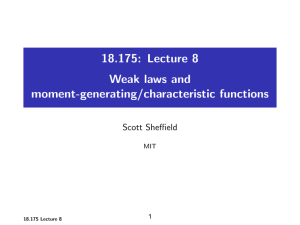18.440: Lecture 30 Weak law of large numbers Scott Sheffield MIT
advertisement
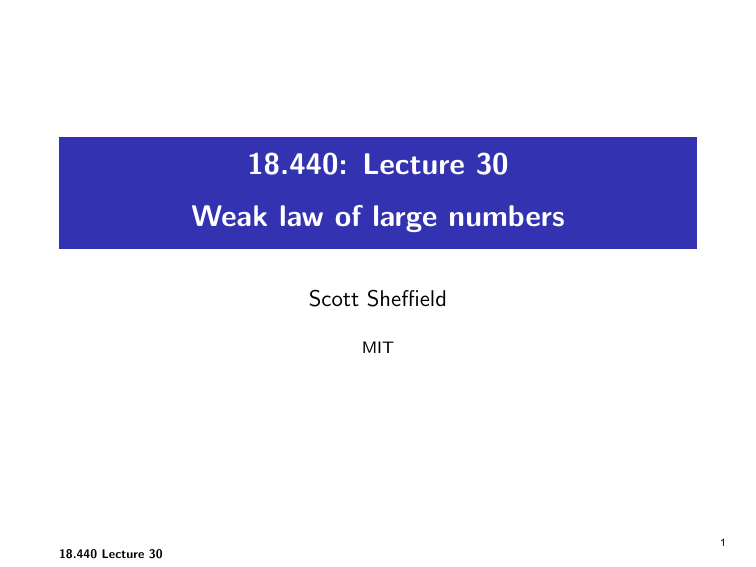
18.440: Lecture 30
Weak law of large numbers
Scott Sheffield
MIT
1
18.440 Lecture 30
Outline
Weak law of large numbers: Markov/Chebyshev approach
Weak law of large numbers: characteristic function approach
2
18.440 Lecture 30
Outline
Weak law of large numbers: Markov/Chebyshev approach
Weak law of large numbers: characteristic function approach
3
18.440 Lecture 30
Markov’s and Chebyshev’s inequalities
I
I
I
Markov’s inequality: Let X be a random variable taking only
non-negative values. Fix a constant a > 0. Then
]
P{X ≥ a} ≤ E [X
a .
Proof:
( Consider a random variable Y defined by
a X ≥a
Y =
. Since X ≥ Y with probability one, it
0 X <a
follows that E [X ] ≥ E [Y ] = aP{X ≥ a}. Divide both sides by
a to get Markov’s inequality.
Chebyshev’s inequality: If X has finite mean µ, variance σ 2 ,
and k > 0 then
P{|X − µ| ≥ k} ≤
I
σ2
.
k2
Proof: Note that (X − µ)2 is a non-negative random variable
and P{|X − µ| ≥ k} = P{(X − µ)2 ≥ k 2 }. Now apply
Markov’s inequality with a = k 2 .
18.440 Lecture 30
4
Markov and Chebyshev: rough idea
I
Markov’s inequality: Let X be a random variable taking only
non-negative values with finite mean. Fix a constant a > 0.
]
Then P{X ≥ a} ≤ E [X
a .
I
Chebyshev’s inequality: If X has finite mean µ, variance σ 2 ,
and k > 0 then
P{|X − µ| ≥ k} ≤
σ2
.
k2
I
Inequalities allow us to deduce limited information about a
distribution when we know only the mean (Markov) or the
mean and variance (Chebyshev).
I
Markov: if E [X ] is small, then it is not too likely that X is
large.
I
Chebyshev: if σ 2 = Var[X ] is small, then it is not too likely
that X is far from its mean.
5
18.440 Lecture 30
Statement of weak law of large numbers
I
I
Suppose Xi are i.i.d. random variables with mean µ.
n
Then the value An := X1 +X2 +...+X
is called the empirical
n
average of the first n trials.
I
We’d guess that when n is large, An is typically close to µ.
I
Indeed, weak law of large numbers states that for all > 0
we have limn→∞ P{|An − µ| > } = 0.
I
Example: as n tends to infinity, the probability of seeing more
than .50001n heads in n fair coin tosses tends to zero.
6
18.440 Lecture 30
Proof of weak law of large numbers in finite variance case
I
As above, let Xi be i.i.d. random variables with mean µ and
n
.
write An := X1 +X2 +...+X
n
I
By additivity of expectation, E[An ] = µ.
I
Similarly, Var[An ] = nσ
= σ 2 /n.
n2
By Chebyshev P |An − µ| ≥ ≤
I
I
2
Var[An ]
2
=
σ2
.
n2
No matter how small is, RHS will tend to zero as n gets
large.
7
18.440 Lecture 30
Outline
Weak law of large numbers: Markov/Chebyshev approach
Weak law of large numbers: characteristic function approach
8
18.440 Lecture 30
Outline
Weak law of large numbers: Markov/Chebyshev approach
Weak law of large numbers: characteristic function approach
9
18.440 Lecture 30
Extent of weak law
I
I
Question: does the weak law of large numbers apply no
matter what the probability distribution for X is?
n
Is it always the case that if we define An := X1 +X2 +...+X
then
n
An is typically close to some fixed value when n is large?
I
What if X is Cauchy?
I
Recall that in this strange case An actually has the same
probability distribution as X .
I
In particular, the An are not tightly concentrated around any
particular value even when n is very large.
I
But in this case E [|X |] was infinite. Does the weak law hold
as long as E [|X |] is finite, so that µ is well defined?
I
Yes. Can prove this using characteristic functions.
10
18.440 Lecture 30
Characteristic functions
I
Let X be a random variable.
I
The characteristic function of X is defined by
φ(t) = φX (t) := E [e itX ]. Like M(t) except with i thrown in.
I
Recall that by definition e it = cos(t) + i sin(t).
I
Characteristic functions are similar to moment generating
functions in some ways.
I
For example, φX +Y = φX φY , just as MX +Y = MX MY , if X
and Y are independent.
I
And φaX (t) = φX (at) just as MaX (t) = MX (at).
I
And if X has an mth moment then E [X m ] = i m φX (0).
I
But characteristic functions have an advantage: they are well
defined at all t for all random variables X .
(m)
11
18.440 Lecture 30
Continuity theorems
I
I
I
I
Let X be a random variable and Xn a sequence of random
variables.
Say Xn converge in distribution or converge in law to X if
limn→∞ FXn (x) = FX (x) at all x ∈ R at which FX is
continuous.
The weak law of large numbers can be rephrased as the
statement that An converges in law to µ (i.e., to the random
variable that is equal to µ with probability one).
Lévy’s continuity theorem (see Wikipedia): if
lim φXn (t) = φX (t)
n→∞
I
for all t, then Xn converge in law to X .
By this theorem, we can prove the weak law of large numbers
by showing limn→∞ φAn (t) = φµ (t) = e it µ for all t. In the
special case that µ = 0, this amounts to showing
limn→∞ φAn (t) = 1 for all t.
18.440 Lecture 30
12
Proof of weak law of large numbers in finite mean case
I
As above, let Xi be i.i.d. instances of random variable X with
n
. Weak law of large
mean zero. Write An := X1 +X2 +...+X
n
numbers holds for i.i.d. instances of X if and only if it holds
for i.i.d. instances of X − µ. Thus it suffices to prove the
weak law in the mean zero case.
I
Consider the characteristic function φX (t) = E [e itX ].
I
∂ itX
Since E [X ] = 0, we have φ0X (0) = E [ ∂t
e ]t=0 = iE [X ] = 0.
I
Write g (t) = log φX (t) so φX (t) = e g (t) . Then g (0) = 0 and
(0)
(by chain rule) g 0 (0) = lim→0 g ()−g
= lim→0 g ()
= 0.
I
Now φAn (t) = φX (t/n)n = e ng (t/n) . Since g (0) = g 0 (0) = 0
we have limn→∞ ng (t/n) = limn→∞ t
g ( nt )
t
n
= 0 if t is fixed.
Thus limn→∞ e ng (t/n) = 1 for all t.
I
By Lévy’s continuity theorem, the An converge in law to 0
(i.e., to the random variable that is 0 with probability one).
13
18.440 Lecture 30
MIT OpenCourseWare
http://ocw.mit.edu
18.440 Probability and Random Variables
Spring 2014
For information about citing these materials or our Terms of Use, visit: http://ocw.mit.edu/terms.
